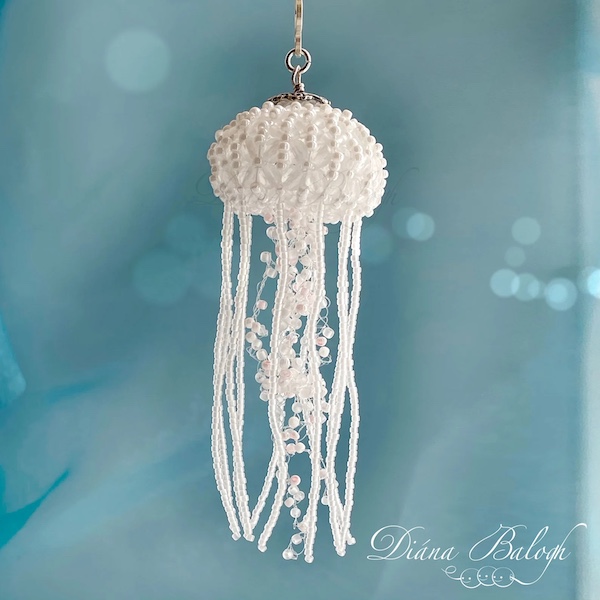Dead jellyfish are like amorphous blobs on beaches. But they are wonderfully graceful in water with their bell-shaped forms complete with trailing tentacles. So it is no wonder artisans love to use the jellyfish as an inspiration in their designs.
The techniques featured here range from beadwork to wirework and polymer clay. First up is the gorgeous jellyfish beaded pattern and tutorial by Diana Balogh of DiasJewelryShop shown above. I have featured this marvellously innovative beader before.
The beautiful jellyfish bead embroidered pendant tutorial below is by SarahCryerBeadwork. Do check out Sarah's store as she has other lovely beadwork tutorials.
The contemporary touch to Bettina's polymer clay jellyfish earrings tutorial is so pretty. She has many other innovative polymer clay tutorials in BettinaWelker. Another must visit! I featured her work before here.
I have featured this talented wire artist before. LenaSinelnikArt never fails to impress as with her wire wrapped jellyfish pendant tutorial.
This one is her wire wrapped jellyfish pendant tutorial.
Disclosure
The Immortal Jellyfish
The familiar shape of the jellyfish to us is really just one stage, called the medusa, in its life cycle. This is the adult or sexual stage.. The jellyfish starts off as a floating fertilized egg which then attaches to a rock or sea bottom and transforms into a larval form (planula). This then develops into a polyp which then buds off immature medusae (ephyrae) which later develop into mature medusa.
 |
| Picture Source : Smithsonian Ocean |
One really remarkable jelly fish is the very tiny (0.18 inch) Turritopsis dohrnii originally found in the Mediterranean in the 1880s but now found worldwide.
It's the only species which is biologically immortal. This jellyfish is capable of reverting to an earlier stage if it is injured or is environmentally threatened i.e. starving. It becomes a tiny blob of tissue which becomes a polyp again. This is akin to a butterfly reverting back to its caterpillar form or a frog back to a tadpole!
So by changing between forms in response to stress or harm, it can live forever.
This form of cell recycling called transdifferentiation intrigues stem cell research scientists as they look for ways to replace cells damaged by disease which may, in the future, include gene therapy and regenerative medicine.
 |
| Picture Source : American Museum of Natural History |
Before You Go:
This blog may contain affiliate links. I do receive a small fee for any products purchased through affiliate links. This goes towards the support of this blog and to provide resource information to readers. The opinions expressed are solely my own. They would be the same whether or not I receive any compensation.
______________________________
Original Post by THE BEADING GEM





Fascinating! thank you for sharing.
ReplyDeleteGlad you enjoyed a little bit of science with the tutorials!
DeleteSo many beautiful ways to make beautiful jellyfish!
ReplyDelete